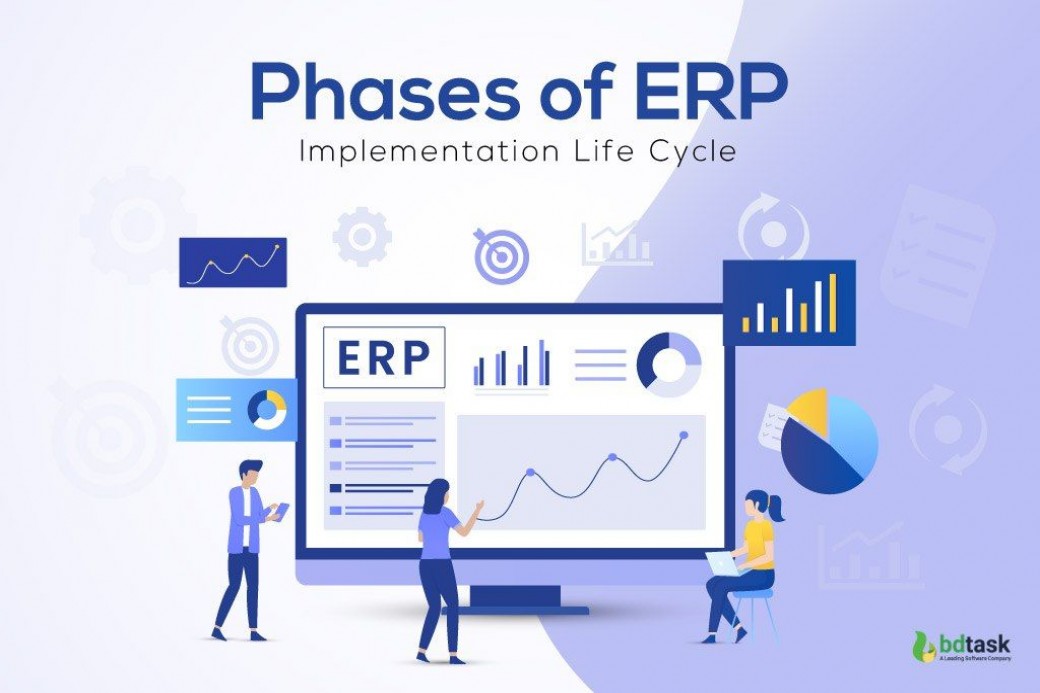Phases of ERP Implementation Life Cycle [06 Stages Should be Done Properly]

The ERP implementation life cycle is the process that companies use to install and implement an enterprise resource planning (ERP) system. In short, the ERP implementation life cycle is the ERP development process. The first step in the ERP implementation life cycle is to select the right software for your company. This decision is based on many factors, such as business size, industry, budget, and specific needs. Once you've selected the software, you'll need to install it and configure it to meet your company's specific needs.
After the software is installed, you'll need to train your employees on how to use it. This training is essential to ensure that everyone is using the system correctly and efficiently. Once the system is up and running, you'll need to monitor it regularly to ensure that it's functioning properly and that your employees are using it effectively.
ERP implementation is a complex and time-consuming process, but it's essential for businesses that want to streamline their operations and improve their efficiency. Following these steps will help you successfully implement an ERP system in your company.
What is ERP?
An ERP stands for Enterprise Resource Planning. It is a software application that helps businesses manage their core operations, such as inventory management, financial accounting, and human resources. ERP systems are used by organizations of various kinds, from tiny firms to multinational corporations.
ERP systems are designed to be comprehensive, covering all aspects of a business's operations. They are also modular, meaning they can be customized to meet a company's specific needs. ERP systems typically include modules for financial accounting, inventory management, human resources, and customer relationship management or CRM.
ERP systems are created by software vendors, who offer different versions of the software to businesses of different sizes. For example, SAP offers a version of its ERP software for small businesses, called SAP Business One, and a separate version for large enterprises, called SAP ECC.
The benefits of using an ERP system include increased efficiency, improved decision-making, and reduced costs. ERP systems can help businesses automate their operations and reduce their dependence on manual processes. They can also help businesses keep track of their data and make it easier to generate reports.
What is Meant by ERP Implementation Life Cycle?
ERP implementation life cycle is the process of installing an ERP system in a business. This process can be complex and time-consuming, as businesses need to customize the software to meet their specific needs. You need to go through several stages to implement an ERP system into your organization. ERP implementation phases are very important and should be done carefully to ensure the best outcome from the system. Phases of an ERP implementation life cycle include:
- Planing
- Design
- Development
- Testing
- Deployment
- Support & Updates
Why ERP is Required for an Organization?
There are many reasons why a business might need an ERP system. The most common reason is to increase efficiency and automate operations. Other features of ERP system include reducing costs, improving decision-making, and keeping track of data. ERP is important because it helps organizations to be more efficient and productive. It also provides visibility into data, which can help organizations to make better-informed decisions.
Additionally, ERP systems are flexible and customizable, making them able to meet the changing needs of an organization. Finally, ERP systems can help to save money by providing a more efficient way to manage data and business processes. Let’s look at the brief description of the reasons an organization needs an ERP system.
Increasing Efficiency
One of the main benefits of using an ERP system is that it can help businesses automate their operations. Businesses can do more with less, as they will no longer need to rely on manual processes. This can help businesses save time and improve their efficiency.
Businesses can increase up to 36 percent efficiency by implementing an ERP system in their company.
Reducing Cost
Another benefit of using an ERP system is that it can help businesses reduce their costs. This is because businesses will no longer need to use paper records or manual processes. ERP systems can also help businesses save money by reducing the need for overtime pay.
According to a survey, an ERP system can reduce almost 46 percent cost of a company every year.
Improve Decision Making
An ERP system can also help businesses improve their decision-making. This is because an ERP system can provide businesses with real-time data that can be used to make informed decisions.
Keep Track of Data
Finally, an ERP system can help businesses keep track of their data. This is because an ERP system can store all of a business's data in one central location. This can help businesses keep track of their progress and spot any trends.
Phases of ERP Implementation Life Cycle
Implementation of the ERP system requires going through several steps. To get the best out of an ERP system, every step of implementation should be done properly as every step of ERP implementation is important. Implementation of an ERP system can take a long time from 6 months to a year. Let’s look into the ERP implementation life cycle phases.
Step 1: Planning
The first step of implementation of an EPR system comprises studying and choosing a system, forming a project team, and outlining system requirements. The project team will put out the project strategy and goal dates, assign necessary resources, make product and design choices, and manage the project day-to-day.
The ERP project team comprises a sponsor, a project manager, and department representatives. Senior management must be involved to guarantee the project has enough resources and to execute change across the company. The team may employ an external consultant or ERP implementation partner for system design and configuration. It should also include IT and a report writer who will create customized reports for users throughout the firm.
The team's early purpose is to identify existing difficulties, such as process inefficiencies and ERP system needs. If the firm has produced an ERP business case, it may have already specified broad business concerns and objectives for the deployment, such as a speedier financial closure, enhanced operational insight, or IPO preparation. These may guide extensive study, including documentation of current procedures, and system development.
As the firm grows its needs, the team may pick and buy an ERP system. Whether to employ on-premises or cloud-based ERP is a big issue. An on-premises solution is installed in your organization's data center. Cloud-based ERP is a subscription service available online, so it's easier to adopt and needs less IT expertise.
Step 2: Design
The second phase of the ERP implementation life cycle includes designing. The design phase develops a thorough ERP system design from specific requirements and existing processes. This involves creating new, more efficient workflows and business processes. Users should be included in the design phase since they know business processes best. Involving them in the design ensures they'll use the new system.
Gap analysis may reveal process subtleties and unique quirks that may necessitate ERP software modification or adjustments to workflow or processes to align with the ERP system. The team may show its implementation partner or supplier the shortcomings and seek remedies.
Step 3: Development
Then comes the third step which is development. Development may begin with precise design requirements. Configure and customize the software to support revised processes. It may also entail integrating current corporate software that won't be replaced by ERP. An on-premises ERP system requires installing hardware and software.
Alongside software development, the team should provide user training materials. It must also organize data migration, which may be challenging since it entails extracting, processing, and loading data from many systems with different formats and duplicate or inconsistent information. In this phase, the project team should decide which historical data to move, avoiding unnecessary data.
Step 4: Testing
After development comes the fourth step which is testing. But parallel testing and development is possible. The project team may test modules and features, make corrections, and retest. Or, it may test one ERP module while developing another. Initial testing of the software's fundamental features should be followed by thorough testing of its complete capabilities, including letting certain workers use it for their daily tasks. This phase should involve data testing and end-user training. To enhance your understanding of AI's role in testing and automation, preparing with Microsoft AI-900 practice test dumps can be highly beneficial. This phase should involve data testing and end-user training.
Most suppliers provide pre- and post-deployment training options. The company should also utilize the training materials generated during development. Resources that address end-users daily tasks are valuable.
Step 5: Deployment
The fifth step of the ERP implementation life cycle is Development which is the ERP systems launch and your goal. Despite your best attempts to prepare staff for the transition, there may be many moving components and puzzled employees. The project staff should be ready to answer queries, assist users, and repair problems. If required, your implementation partner can troubleshoot. User adaptation and productivity benefits may take time.
Some data may be transferred before deployment, but current transactions must be migrated before going live. Some firms adopt all ERP modules simultaneously, while others concentrate on high-priority modules or processes first. Some firms use older systems in tandem with the new ERP deployment to avoid risk, but this increases project costs and reduces user productivity.
Step 6: Support & Updates
After deployment, nurturing your ERP installation keeps users happy and ensures corporate success. During this phase, the project team is still responsible for the ERP system, but its emphasis shifts to user input and system adjustments. New features may need extra development and setup. New employees will require system training. On-premises ERP systems need frequent software updates and hardware upgrades. Your vendor may automatically update your cloud-based ERP software.
ERP Implementation Best Practices
Functions of ERP in an organization include increased efficiency and automating every task of an organization. So the implementation of ERP is crucial for businesses. But making a phased implementation plan won't guarantee success on its own. Best practices for ERP implementation are just as important in each phase as they are in the beginning. ERP implementation best practices are:
1. Define the business case for the ERP project.
2. Assemble a strong project team with members from different departments and levels within the organization.
3. Develop a realistic schedule for the project.
4. Choose an ERP system that fits the needs of the organization.
5. Customize the ERP system to meet the specific needs of the organization.
6. Train the project team and end users on how to use the system.
7. Test the system thoroughly before going live.
8. Go live with the system gradually, starting with a pilot group of users.
9. Monitor and manage the system after it goes live.
10. Review the project regularly and make changes as needed.
The Risks of Not Having an ERP Solution
An ERP system can be very expensive and the implementation process of an ERP system is very difficult and time-consuming. But the ERP system brings significant changes to a company and increases income and decreases cost. Also, it saves time and increases collaboration. And there are several risks associated with not implementing an ERP solution. These risks can include:
- Inefficiency: The current system may be inefficient and unable to meet the needs of the organization.
- Lack of Visibility: The current system may lack visibility into data, making it difficult to make informed decisions.
- Limited Functionality: The current system may be limited in functionality, making it difficult to scale.
- Lack of Flexibility: The current system may be inflexible and unable to meet the changing needs of the organization.
- Increased Costs: The current system may be more expensive to maintain than an ERP system.
- Decreased Productivity: The current system may reduce productivity and make it difficult to compete.
How Do You Choose ERP Software?
ERP software selection is complicated. There are many things to think about when selecting ERP software. The first step is to assess the needs of the organization and determine what type of system would be the best fit. Choosing the best ERP software for your business is difficult but once you have a general idea of what you need, you can evaluate different ERP systems. Some things to keep in mind when choosing ERP software include:
- Ease of Use: The system should be simple to understand and easy to use. Moreover, accessing and managing the system should be simple.
- Functionality: The system should have all the features and functionality you need.
- Flexibility: The system should be flexible and customizable to meet your organization's specific needs.
- Support: The vendor should offer good customer support in case you have any problems with the system.
- Cost: The system should be affordable and offer a good return on investment.
If you are still struggling to choose the suitable ERP system for your business, then read this article to learn about the 9 Tips on Buying An ERP Software. This will help you choose the best ERP system for your company.
Conclusion
ERP systems are important for organizations because they can help to improve efficiency and productivity. They also provide visibility into data, which can help organizations to make better-informed decisions. Additionally, ERP systems are flexible and customizable, making them able to meet the changing needs of an organization. Finally, ERP systems can help to save money by providing a more efficient way to manage data and business processes. So if you want to achieve all these benefits of ERP in your organization make sure to plan and execute the steps of ERP implementation wisely.










